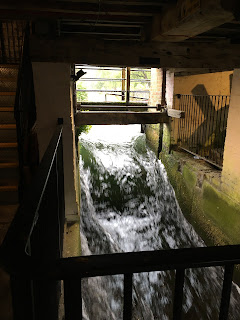We drove south on a wet, wet Saturday in August. The windscreen wipers swished endlessly back and forth, as we debated whether it was worth stopping anywhere except for the overcrowded motorway services.
By the time we reached Winchester, the wipers had subsided to an occasional flick across the screen. We decided to stop. Of course, as soon as we left the car park there was a brief shower, but we ducked into the City Mill, now a National Trust property. There was a large room full of the usual kind of displays about flour milling; a recently renovated garden; and downstairs, the mill race running at full tilt. The mill is built right across the River Itchen.
 |
| Winchester City Mill garden |
 |
| The mill race |
 |
| Water wheel (awaiting renovation) |
We stayed dry as we explored further into Winchester. There was even some blue sky for our selfie by the cathedral! But as we walked back to the car the rain hit us like a hose on full blast. An overhanging building provided some slight shelter, but the water was bouncing off the pavement and into our shoes.
 |
| by Winchester Cathedral |
It was a damp drive to our hotel in Christchurch. The room really wasn't designed to hang up so many wet garments - a heated clothes airer would have been nice! Still, we got ourselves dry, and had dinner at a nearby Toby Carvery, where a friendly but extremely overworked waiter was trying to tend to a dozen tables at once. I think someone must have been off sick.
Next day, we joined the crowds swarming into Beaulieu for the Supercar Weekend. Toby and Graham nearly swooned at the sight of so much automotive engineering all in one place. If I try to tell you what was there, I'll only get all the names wrong, but just imagine all the most expensive cars you've ever heard of. Theo sat in his dream car - a bright green Lamborghini.
Fortunately for me, there was someone else there who preferred books.
Later we ate fish and chips at Highcliffe, and walked along the beach in the most gorgeous evening light. Toby tried to dodge waves, but they were too quick for him. He got wet feet again.
On our final day we drove to Milford-on-Sea, where we'd previously enjoyed the beach and the view of the Needles. We hadn't made it to Hurst Castle on that visit, so that was our destination for today. It's right at the end of a shingle spit. Shingle isn't the nicest stuff to walk on, but it was a pleasant enough amble in the morning sunshine.
Hurst Castle was definitely built for fortification, not for looks. The original fort was established by Henry VIII in 1544. In the centuries since then, every time the fear of invasion loomed, the castle got a few more bits added. A couple of lighthouses were plonked nearby as well. One was actually in the castle, but the lighthouse keepers had to have their own separate entrance.
Sadly, the shingle beach which used to protect the castle's seaward side has washed away. Part of the castle wall collapsed in 2021. English Heritage is doing its best to protect the remains, but you do have to wonder how much money and rock they can throw at it, before conceding to the power of the sea.
For now, the sea was being very well-behaved. But it was time for us to head inland once more. It was a long journey home, but at least the windscreen wipers got a rest this time.













Comments